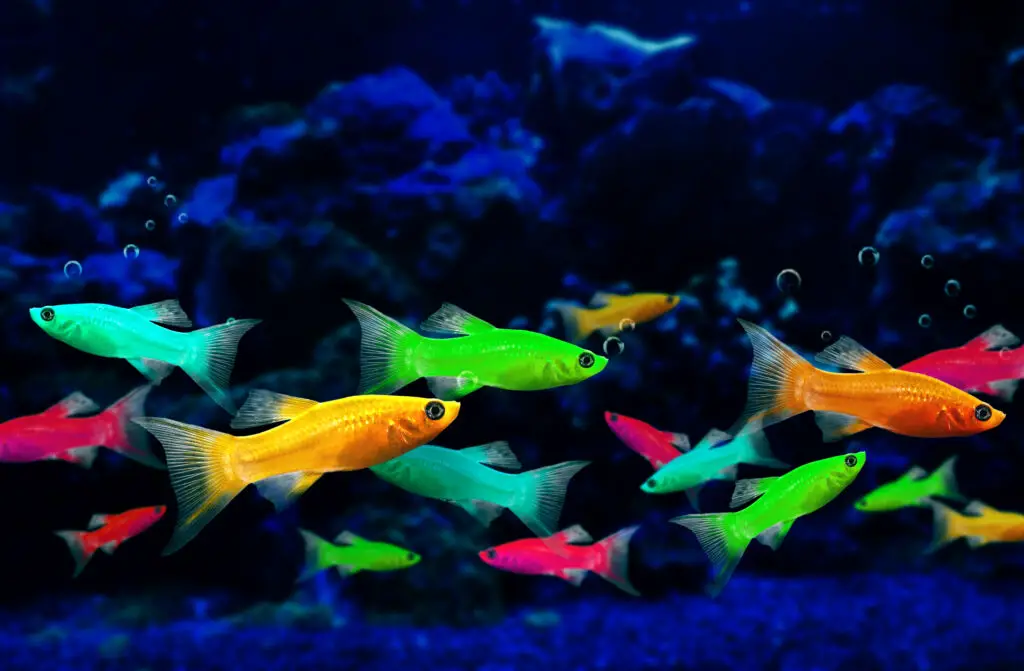
GloFish is a patented fluorescently genetically modified fish created from numerous different fish species, such as zebrafish and tiger barb. As the name suggests, GloFish glo when a UV light is present. Koi fish are beautiful variations of carp species specifically bred for their beautiful colors. Both are beautiful fish and very popular; the question is can GloFish live with Koi fish?
GloFish and Koi fish can’t live happily together. GloFish requires minimum-mineral soft water, whereas Koi fish do best in mineral-rich hard water. GloFish are tropical fish in need of warm water temperatures of up to 82°F, whereas the cold-water Koi’s immune system functions best at 59°F.
It’s not impossible to have GloFish and Koi fish live together, but the differences in living requirements make it hard to keep both sides of the fish tank happy. A fish tank suits the GloFish better than the Koi, who is happiest in a spacious pond environment.
Pro Tip: If you’re tired of wasting money and making costly mistakes on the koi-keeping hobby or are thinking about buying koi fish but don’t know where to start, I strongly suggest you check out this ebook. I recently read this ebook, and it contains SO much useful information, such as:
- 3 proven steps to identify koi fish diseases
- WARNING: 3 things you should NEVER do when it comes to caring for koi
- When to seek professional help when it comes to looking after your koi
Can GloFish Live with Koi Fish?
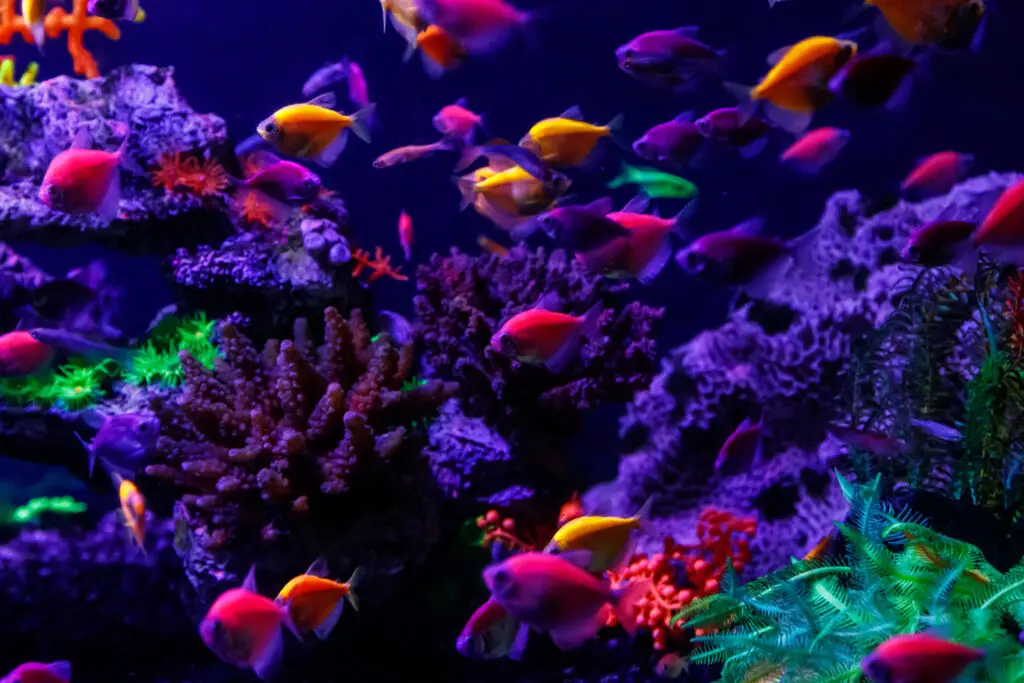
GloFish and Koi fish are fish with a striking combination of colors. GloFish does best in controlled aquarium environments and is a tropical fish that love warmer water. Koi fish is cold water carp fish that thrives in koi ponds with lots of space and prefers colder water.
The sentence above tells you that even if putting these two fish species together is possible, you will struggle to keep both happy and healthy simultaneously. Here are more reasons why GloFish can’t live with Koi fish.

Reasons Why GloFish Can’t Live with Koi Fish
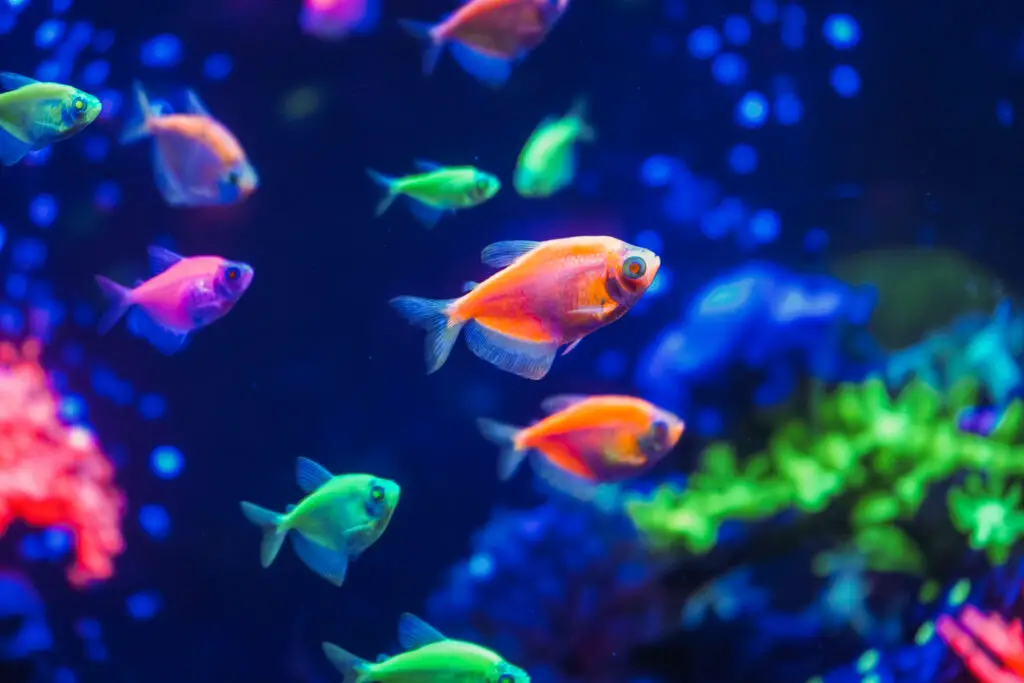
Some fish can comfortably live with each other in a community aquarium or pond. The more similar the species are regarding water requirements, size, level of care, feeding requirements, characteristics, and overall temperament, the higher the chance that they live happily ever after.
Let’s discuss the reasons why it’s not a good idea to put GloFish and Koi together:
Different Water Requirements
Koi fish are carp, and all the different color varieties come from the Amur carp, making them cold-water fish.
Give a Koi fish a pond with loads of space (Koi fish produce a lot of waste), water temperature between 59° F – 77° F, and well-oxygenated water, combined with regular water changes, and you’re good to go. The immune system of a Koi is most active at 59° F.
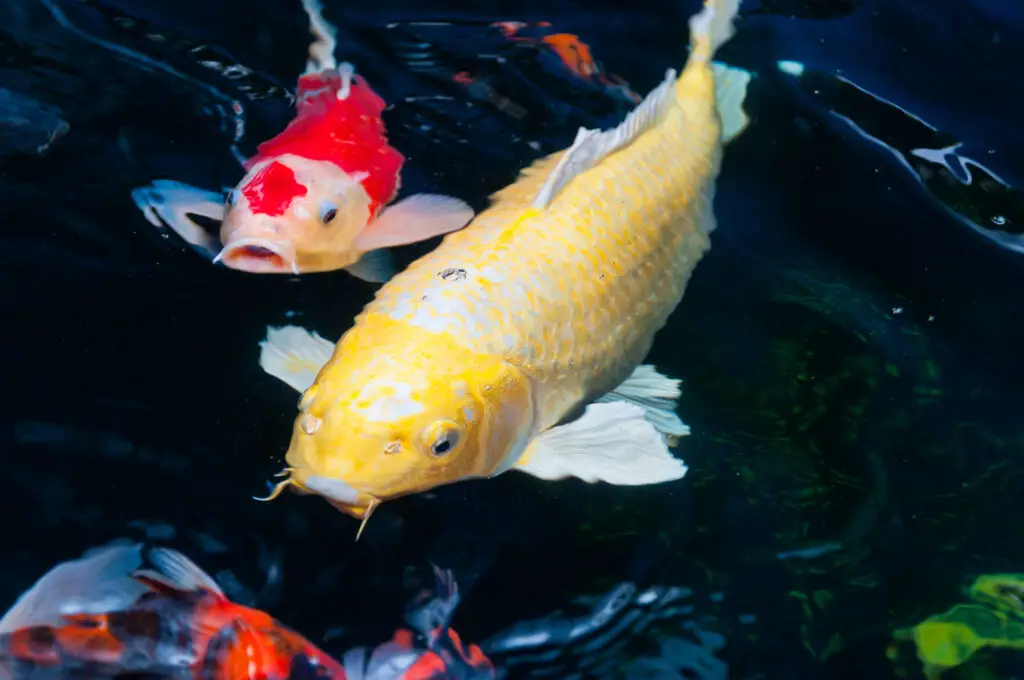
Now take into consideration the water requirements of a GloFish. A GloFish thrives in a controlled environment, such as an aquarium with good filtration systems and appropriate water parameters.
These delicate fish don’t do well in environments with lots of waste and subsequent algae. Fish waste turns into an ammonia source, and Koi fish produce a lot of waste, which can result in the GloFish getting sick regularly. If the waste situation isn’t closely monitored, it can even result in death.
Optimal water temperature for most of the different species of GloFish range between 72°F – 82°F, as they are tropical fish, which means you have to have an aquarium water heater to ensure stable temperature.
Bacteria are most active at higher temperatures, such as 82°F, and water at this temperature could affect the immune system of the Koi.
Putting them together in an aquarium or pond will mean that the Koi never lives in the temperature best for its immune system, or the GloFish lives in water that feels like the Arctic, especially in the 59°F range.
If you put GloFish outside in a Koi Pond, you can expect to replace the fish after every winter, as none of the GloFish species can survive winter outdoors.
If you would like to learn more about Koi fish’s water requirements, you can read my blog posts:
Can Koi Fish Live In Cold Water?
Can Koi Fish Live In A Tank?

Maintaining temperature and water parameters that work for both species will be challenging, and both parties won’t be happy at the same time. Take the following water parameters, for example:
- Water hardness: Refers to the mineral content (calcium, silica, iron, borate, and magnesium) found in the water. Water with low mineral content is classified as soft, while water with high mineral content is classified as hard.
- GloFish does best in soft water with little mineral content.
- Koi fish do best in hard (magnesium and calcium-rich) water, as these minerals are required to help the Koi with many biological processes, such as regulating electrolytes in the blood, creating new bone tissue, and other metabolic processes.
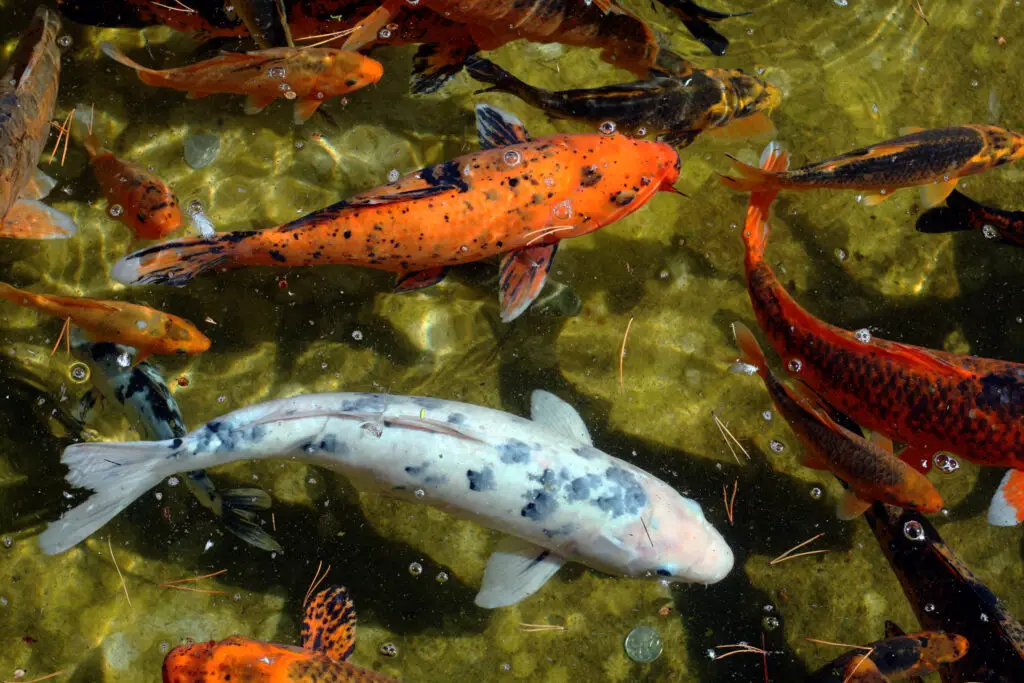
With regards to optimum pH levels in the water, GloFish thrives in water with a low pH level (6.5 to 7.5), while Koi thrives in water with a higher pH level, from 6.5 up to 8.5.
When either of these fish falls below or above the parameters, it could lead to diseases such as alkalosis and acidosis, which can lead to the following:
- Underweight fish
- Excess body slime
- Blood-streaked fins
- Unusual behavior
- Death
Fish Temperament and Size Disparity
Koi fish are normally very chilled and peaceful fish. However, these robust fish can act rough and aggressive when feeding and during mating season.
GloFish are fragile and small compared to the bigger Koi fish, leaving them extremely vulnerable to aggression and predation, and they can easily get injured during a feeding frenzy.

Due to the major size disparity between the two fish species (2.0 in compared to 3 ft), it does happen that bigger Koi fish accidentally eat small fish that fit into their mouths.
On the other hand, should you put tiger barb GloFish with any long-finned fish, you can expect some serious problems, as tiger barbs, which are aggressive by nature, and many of the GloFish species for that matter, are known to be fin-nipping fish species.
Factors To Consider When Putting Different Fish Species Together
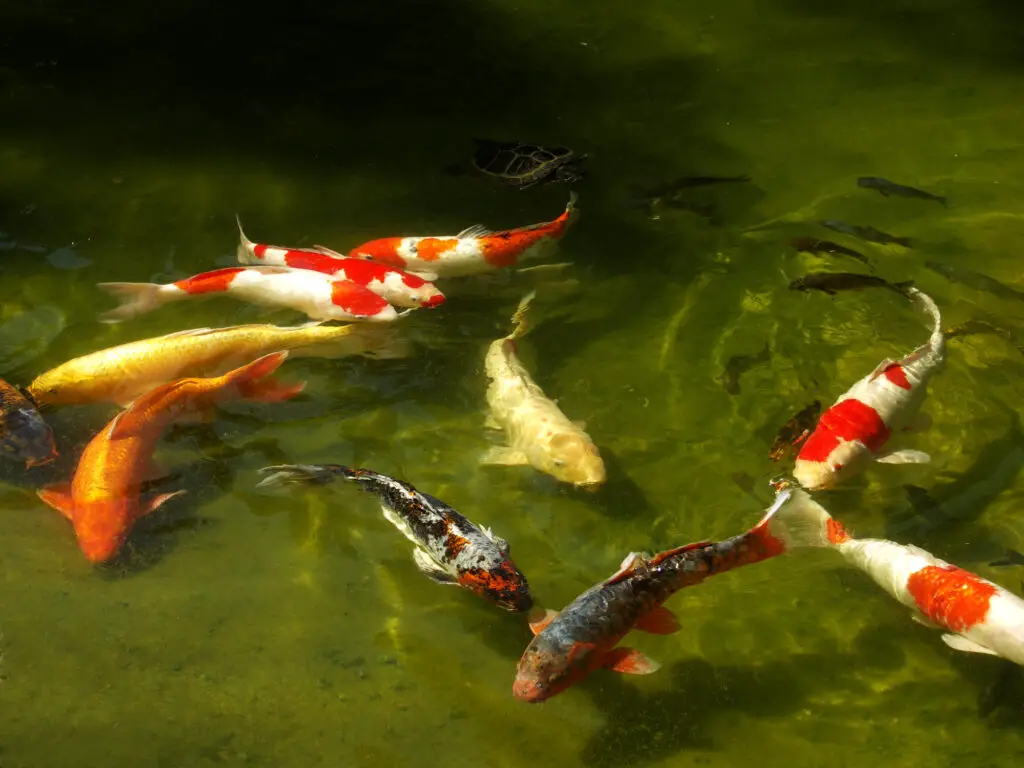
The following important factors must be taken into consideration before adding different fish species to one living environment:
- The aggressiveness of the fish: You don’t want to put aggressive fish with your beloved Koi; rather, choose friendly and tranquil fish, ensuring that all fishy friends in the tank are happy.
- Size of the fish: Housing fish similar in size to the Koi is a smart move. It will result in fewer fights and less injury to all species in the tank or pond.
- Temperature requirement: Choose fish with the same or similar water temperature requirements as Koi fish. Tropical fish prefer warmer water, while Koi fish are happiest in colder water.
- Feeding habits: Ensure you pair fish that won’t fight the Koi for food; choose a bottom feeder as a mate so that all fish can share the spoils.
- Low maintenance water requirements: Choose fish that share the same water requirements as the Koi, as any fish with special needs that differ from the normal water parameters of a Koi can become difficult to manage.
If you would like to learn which animals can live with koi fish, you can read the following blog posts:
What Fish Can Live with GloFish?

GloFish is a very popular display fish since they appear fluorescent under UV lights, but that doesn’t mean these colorful fish can live happily with all aquarium fish.
It’s a well-known fact amongst GloFish owners that most of the GloFish species can’t live together in harmony, and you have to take special care when placing these species together in an aquarium.
GloFish can be divided into the following species:
- Zebra fish (Danio rerio)
- Tetra (Gymnocorymbus ternetzi)
- Tiger barbs (Puntius tetrazona)
- Betta (Betta trifasciata)
- Rainbow shark (Epalzeorhynchos frenatum)
Fish That Can Live with GloFish Tetras
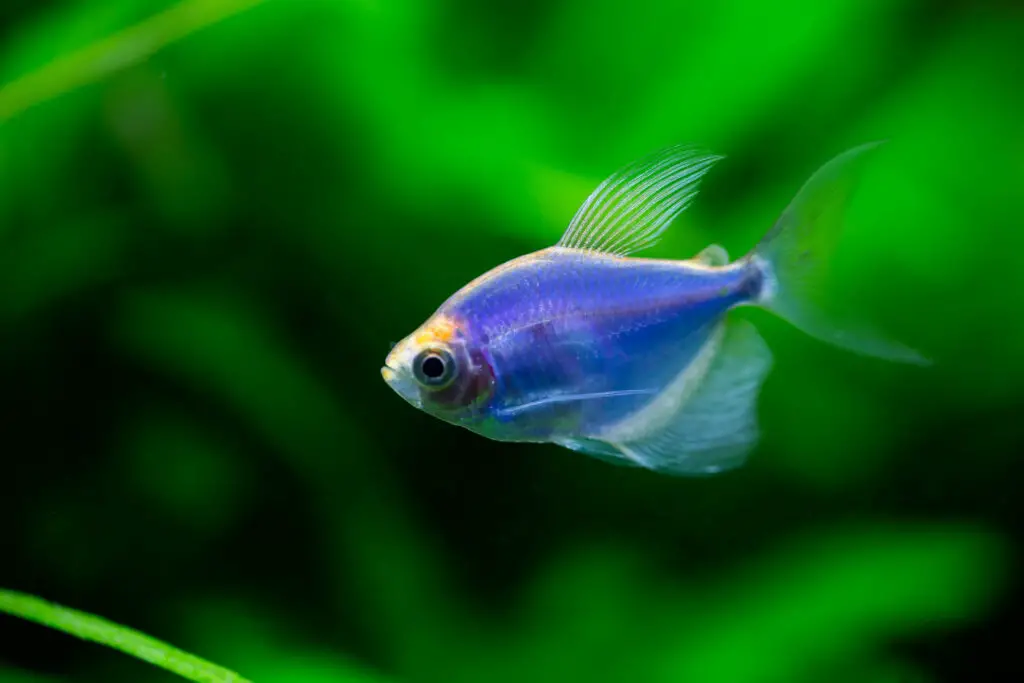
GloFish tetras move in schools, so when you add them to an aquarium, please ensure that you have at least five tetras as a group. Tetras do well with other small, friendly fish that are generally peaceful.
When you add less than five tetras to the mix, the fish might become aggressive and start nipping at fins. Being tropical fish, GloFish tetras do best in water with a temperature range between 72°F-80°F.
| Fish Species That Can Live with GloFish Tetras | Temperature Requirements | Size |
| Neon Tetras | 72°F – 76°F | 1.5 in |
| Cardinal Tetras | 73°F – 81°F | 1.25 in |
| Chili Rasboras | 68°F – 80°F | 0.75 in |
| Harlequin Rasboras | 75°F – 80°F | 2.0 in |
| Hatchet Fish | 75°F – 80°F | 2.5 in |
| Dwarf Gourami | 72°F – 82°F | 3.5 in |
| Clown Pleco | 75°F – 82°F | 3.5 in |
| Zebra Loaches | 73°F – 80°F | 4.0 in |
| Guppies | 75°F – 82°F | 2.0 in |
| Cherry Shrimp | 65°F – 75°F | 1.5 in |
Fish That Can Live with GloFish Danios
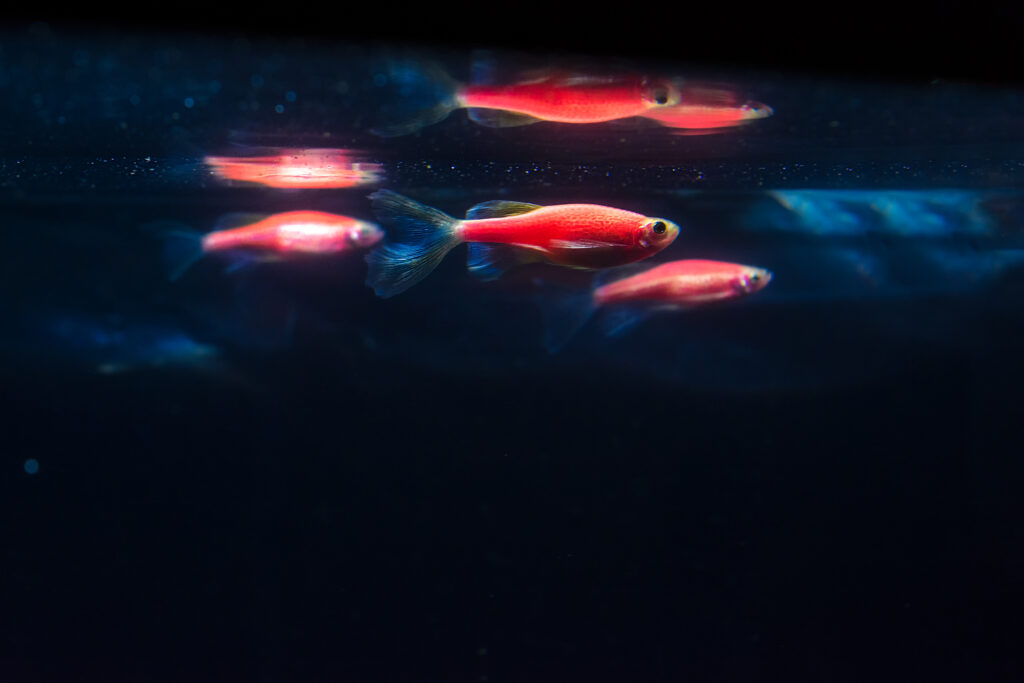
Genetically modified zebra danios, GloFish danios are known to get along with almost any fish species in an aquarium. Fish in the same size range with similar tank requirements typically do well with the super-active GloFish danios.
Avoid big and aggressive fish species, and try to include at least 5 GloFish danios in a tank as they find safety in numbers. When numbers total less than five, the GloFish danios may become aggressive.
| Fish Species That Can Live with GloFish Danios | Temperature Requirements | Size |
| Ember Tetras | 73°F – 84°F | 0.80 in |
| Cardinal Tetras | 73°F – 81°F | 1.25 in |
| Swordtails | 72°F – 79°F | 5.5 in |
| Harlequin Rasboras | 75°F – 80°F | 2.0 in |
| Platies | 70°F – 82°F | 2-3 in |
| Honey Gourami | 71°F – 82°F | 2.2 in |
| Kuhli Loaches | 75°F – 86°F | 2.5 in |
| Corydoras | 75°F – 82°F | 3.5 in |
| Guppies | 75°F – 82°F | 2.0 in |
| Three-Spotted Gourami | 73°F – 82°F | 4-5 in |
| Ghost Shrimp | 65°F – 85°F | 1.5 – 3.0 in |
Fish That Can Live with GloFish Barbs
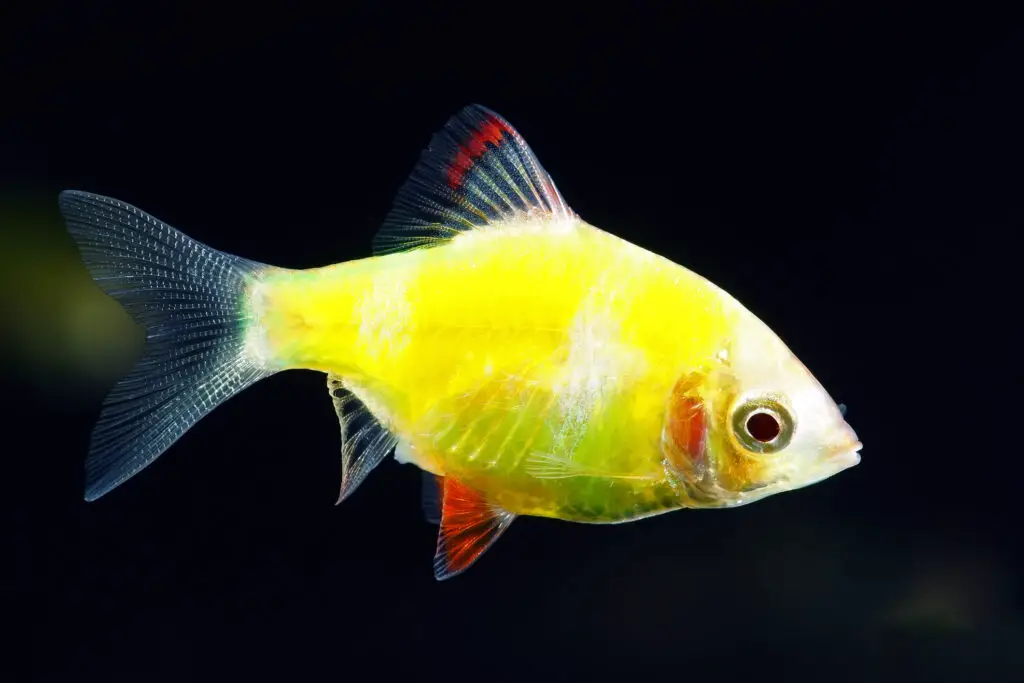
GloFish barbs are genetically modified tiger barbs. And yes, they are as aggressive as the originals and notorious nippers of fins. The most effective method to tone down the aggressive behavior is to ensure that you place them together with a minimum of seven other GloFish barbs.
GloFish barbs fight for dominance within their specific groups by bumping, chasing, and nipping at each other. Don’t place GloFish barbs with fish species with long fins, such as angelfish, GloFish bettas, or goldfish.
Pairing them with slightly larger fish will ensure that these aggressive fish will be reluctant to pester and attack like they tend to do when pushing around smaller fish species. GloFish barbs enjoy temperatures between 77°F – 82°F.
| Fish Species That Can Live with GloFish Barbs | Temperature Requirements | Size |
| Neon Tetras | 72°F – 76°F | 1.5 in |
| Tinfoil Barbs | 72°F – 77°F | 7.0 in |
| Red-Tailed Sharks | 72°F – 79°F | 4-6 in |
| Mollies | 75°F – 80°F | 3-5 in |
| Rosy Barbs | 64°F – 72°F | 6.0 in |
| Dwarf Gourami | 72°F – 82°F | 3.5 in |
| Clown Pleco | 75°F – 82°F | 3.5 in |
| Cherry Barbs | 64°F – 72°F | 6.0 in |
| Corydoras | 75°F – 80°F | 2-5 in |
| Zebra Danios | 65°F – 80°F | 2.0 in |
Fish That Can Live with GloFish Bettas
GloFish bettas are called Siamese fighters and are not to be messed with. Male GloFish bettas are the type of fish that would’ve had to go for anger management classes if they were human. These GloFish will attack a reflection of themselves to protect their territory.

The rule of the fin (thumb) is to never have more than one male GloFish betta in an aquarium and remember that these fish are unsocial to the point of seeming rude. GloFish bettas can get along with species other than themselves.
Due to the long fins of the bettas, their fishy “friends” must be of the kind that doesn’t nip fins. Docile bottom dwellers are ideal pairings.
| Fish Species That Can Live with GloFish Bettas | Temperature Requirements | Size |
| Yoyo Loaches | 75°F – 86°F | 2.5 in |
| Kuhli Loaches | 75°F – 86°F | 2.5 in |
| Mystery Snails | 68°F – 82°F | 2.0 in |
| Harlequin Rasboras | 75°F – 80°F | 2.0 in |
| Corydoras | 75°F – 80°F | 2-5 in |
| Clown Pleco | 75°F – 82°F | 3.5 in |
| Ghost Shrimp | 64°F – 85°F | 1.5-3.0 in |
| Cherry Shrimp | 65°F – 75°F | 1.5-4.0 in |
| Corydoras | 75°F – 80°F | 2-5 in |
| Zebra Loaches | 73°F – 80°F | 4.0 in |
If you would like to learn more about Betta fish, you can read my blog posts:
Fish That Can Live with GloFish Sharks
GloFish sharks derive from the territorial rainbow sharks and are extremely aggressive when it comes to personal space. GloFish sharks typically swim at the bottom of the tank, so bottom-dwelling fish don’t make the best of tank mates.
These sharks need many gallons of space and are prone to biting, butting, and chasing any fish that dares to enter their space. If you must introduce fish, ensure that it’s species that frequent the middle and top areas of the tank.
Adding other shark species is not a good idea, so keep it at one rainbow shark per aquarium.
| Fish Species That Can Live with GloFish Sharks | Temperature Requirements | Size |
| Cherry Barbs | 73°F – 86°F | 2.0 in |
| Rainbow Fish | 72°F – 82°F | 4.7 in |
| Rosy Barbs | 64°F – 72°F | 6.0 in |
| Rasboras | 75°F – 80°F | 2.0 in |
| Tinfoil Barbs | 72°F – 77°F | 7.0 in |
| Danios | 65°F – 80°F | 2.0 in |
| Honey Gourami | 71°F – 82°F | 2.2 in |
Conclusion
Putting GloFish and Koi fish together is not a good idea, as creating the best environment for each fish species will be impossible. The requirements of GloFish and Koi are too different regarding water parameters and water temperature, and the size disparity between the two can cause problems.
There are many better-suited fish mates that you can pair with certain GloFish in an aquarium, as discussed in the article.
Related Blog Posts:
Can African Dwarf Frogs Live With Koi Fish?
Can Parrot Fish Live With Koi?
Can Axolotls Live With Koi Fish?
References
https://pondwiki.com/koi-tank-mates/
Rainbow Shark: Care, Size, Tank Mates, Tank Size & Food (fishlaboratory.com)
What do Glofish eat? Diet | Amounts | Foods | Feeding Guide – Fishkeeping Forever
The Good, The Bad, And The Truth About GloFish | GloFish Care Guide Series Ep.1
Glofish🌟 All you need to know before you buy! Care guide, tips, and info. Ep1: Glo Tetra, JR AquariumGuide to Koi Pond Water Hardness (Is Higher GH Better?) – Pond Informer

